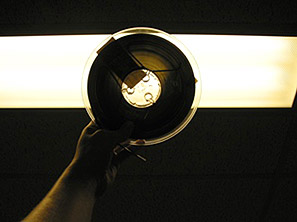
inherent vice: magnetic media
1 Tape Substrates | 2 Tape Recording Layer
The term magnetic media encompasses a variety of materials, including early wire recorders and numerous formats of audiotape and videotape. Computer media, including computer tape, hard drives, and floppy discs are also magnetic media and will be more fully discussed in the section Inherent Vice: Computer Media.
The first machines to record sound magnetically were developed around 1900 by Danish inventor Valdemar Poulson. They included the wire recorder (used for office dictation and recording of telephone messages), as well as a machine that recorded onto steel tape. Both technologies were used well into the 20th century, but magnetic tape eventually became the dominant medium. By the early 1950s, magnetic tape had been almost universally adopted in radio and commercial sound recording. See the History of Sound Recording Technology website for a detailed chronology of the development of sound recordings.
Videotape was developed during the 1950s and quickly became popular. A number of different formats were developed—many of which did not become commercially successful.
Structure
All magnetic tape is made up of two layers: a substrate (backing) and a recording layer (a binder containing magnetic particles). When the tape is passed through a recorder, the magnetic particles are permanently aligned within the binder to produce a copy of the sound waves being recorded. See the CLIR Report Magnetic Tape Storage and Handling for illustrations of magnetic tape structure.
1 Tape Substrates
|
|
The first magnetic tapes used a backing (carrier) made of steel. During the 1930s, German companies developed an audiotape that used a plastic carrier coated with a powder made from material that could be magnetized. At that point, the recording quality of magnetic tape had improved enough to compete with the best disc recorders, and after the end of World War II it gradually became more widely used.
The backing for magnetic tape provides support for the magnetic recording layer as it travels through the tape recorder. Magnetic tape for sound recordings was produced on both acetate and polyester backings, while videotape was produced only on polyester. In magnetic audiotapes, the plastic backing is much thinner than in film, making it much more fragile.
Characteristic Types of Deterioration
Acetate magnetic tapes, like acetate films, suffer from vinegar syndrome, which is described in detail in Session 5: Care and Handling of Photographs. The tapes will emit a vinegar smell and eventually the backing will become brittle and shrink. Polyester tape is much more stable chemically (it is very resistant to oxidation and hydrolysis), but it is subject to physical distortion and mistracking of the tape due to poor winding of the tape pack and/or changes in temperature and relative humidity. Refer again to the CLIR Report Magnetic Tape Storage and Handling for illustrations of poorly wound tape (you will need to scroll down the page).
2 Tape Recording Layer
Magnetic tapes have a recording layer of magnetic particles (iron oxides in acetate magnetic tape; iron oxides, metallic iron, or chromium dioxide in polyester tape) suspended in a polyurethane binder. The binder may also include lubricants and other agents used to improve tape performance. Some tapes also have a binder coating on the back of the tape to reduce friction as the tape moves through the player and to make the tape wind more uniformly on the reel.
Binder Deterioration
The primary means of deterioration for all types of magnetic tape is binder degradation, also known as sticky shed or soft binder syndrome. The polyurethane binder is subject to hydrolysis, in which moisture is absorbed by the binder material and longer molecules within the binder are broken up into shorter ones. The result is a softening of the binder and the presence of a gummy surface residue on the tape. The residue makes the tape stick in the recorder and causes uneven playback, sometimes making the tape jam completely. Occasionally, cleaning or baking the tape will make it usable for long enough to copy it, but this must be done by an experienced professional. Learn more about sticky shed or soft binder syndrome in the A/V Artifact Atlas and listen to audio samples of tapes affected by this syndrome.
An additional problem with the binder is the loss of lubricants over time, which can be due to evaporation, to use of the lubricants during playback, or to hydrolysis or oxidation of the lubricant itself. Lubricant loss will also cause sticking, uneven playback, or jamming of the tape. Relubrication of tapes is possible, but must also be done by an experienced professional.
Magnetic Particle Deterioration
The magnetic particles that store the recorded information are subject to changes in their magnetic properties that can result in loss of the recorded signal. Although the extent of their vulnerability varies, all tapes are subject to demagnetization from exposure to a strong magnetic field, so care must be taken to avoid exposure.
Some magnetic particles are more stable than others (e.g., they keep their magnetic properties longer and are more able to resist demagnetization). Iron oxide particles are the most stable; these are generally used in lower grade audiotapes and low-to-high grade VHS/Beta videotapes. Metal particulate and chromium dioxide particles provide a higher quality output (hence they are used in high quality audiotape), but they are less stable. Metal particulates are also used in 8mm videotape and digital audio and videotapes. The rate of metal particulate and chromium dioxide deterioration is dependent on temperature.

